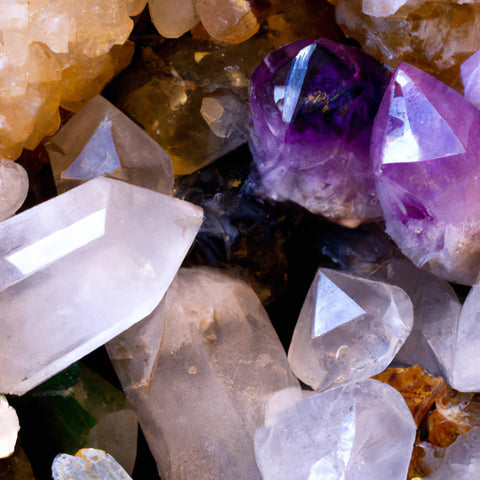
Welcome Crystal Beginners! If you're new to the world of crystals, it can seem overwhelming at first. There's the terminology, the hundreds of different types of crystals with names you've never heard of, and then of course, healing properties, and how to use them! But don’t worry, once you’ve reached the end of this blog, you’ll know everything you need to get started.
A Brief History of Crystals
The first records of crystals being used for healing and magic are from ancient Sumer, in modern-day Iraq. This civilization flourished between 4500 and 2000 BC. The philosopher Plato, writing in the 4th century BC, describes their legendary use in the lost city of Atlantis where they were employed, among other things, for healing and telepathic communication. The ancient Egyptians, Greeks, and Romans all used crystal healing and magic, and writers such as Galen and Pliny the Elder advised that crystals should be worn as a form of medicine for specific ailments.
What Exactly Is A Crystal?
Crystals are solid materials whose atoms are arranged in a highly ordered, repeating pattern extending in all three spatial dimensions. They are mined and sourced from various parts of the world, each with unique properties and uses. Crystals are also used in modern products, from electronics to beauty products, due to their unique properties.
How to Choose A Crystal
1. Intuition Matters
Many experienced crystal users will tell you that the right crystal often chooses you. When you're browsing a selection of crystals, let your intuition guide you. You might be drawn to a particular specimen because of its color, shape, size, or a feeling you get when you hold it. This could be an indication that the crystal's energy resonates with your own.
2. Consider Your Needs
Think about what you are seeking in your life right now. Is it love? Perhaps Rose Quartz, the stone of unconditional love, is calling to you. Are you seeking peace and tranquility? Then Amethyst might be your ideal crystal companion. If you're aiming for abundance, Citrine, known as the Merchant Stone, could be perfect. Researching the metaphysical properties of different crystals can help you align your needs with your selection.
3. Choose a Beginner-Friendly Crystal
As a beginner, you might want to start with crystals known for their versatility and gentle energy. Clear Quartz, for example, is known as the Master Healer and can be used for a variety of purposes. Similarly, Amethyst is excellent for promoting peace and tranquility and is ideal for meditation.
4. The Art of Touch
If possible, try to hold a crystal before you choose it. Notice the sensation you feel in your hand—does it make you feel calm, energized, or perhaps, strangely at home? The physical connection can help strengthen the bond between you and the crystal, facilitating better energy exchange and making your crystal practices more effective.
5. Research Your Seller
Where you buy your crystals from matters. Make sure your crystals are ethically sourced and the seller is knowledgeable about their inventory. A reputable crystal shop, whether online or physical, should be able to provide information about each crystal's origin and properties.
What Are The Best Crystals for Beginners?
1. Clear Quartz
Often referred to as the 'Master Healer,' Clear Quartz is a must-have for beginners. Metaphysically, it's known for amplifying energy and thought, as well as the effect of other crystals. It's believed to promote clarity of mind, helping you to focus and become clear on your dreams and desires.
Physically, Clear Quartz is said to stimulate the immune system and balance the body, making it a staple for any healing work.
2. Amethyst
Amethyst is an all-purpose stone with a high spiritual vibration. Known as the 'Stone of Tranquility and Psychic Power,' it's particularly helpful in calming the mind, enhancing meditation, and aiding in restful sleep.
Physically, Amethyst is often used in dealing with insomnia and ensuring a restful night, making it perfect for anyone struggling with sleep issues. It's also said to help with physical ailments of the nervous system and emotional healing.
3. Citrine
Nicknamed the 'Merchant Stone,' Citrine is popular for manifesting success and abundance, especially in business. It's also known for promoting optimism and motivation, making it great for anyone in need of a confidence boost.
As for physical healing, Citrine is often used for digestive discomfort and metabolism issues, believed to improve one's endurance and overall physical energy.
4. Rose Quartz
Known as the 'Stone of Love,' Rose Quartz is perfect for inviting love of all kinds - romantic, familial, or self-love - into your life. It's believed to open the heart chakra and enhance positive affirmations.
On the physical side, Rose Quartz is said to improve circulation, support the female reproductive system, and aid with issues related to the heart.
5. Black Tourmaline
Black Tourmaline, also known as the 'Stone of Protection,' is known for its ability to transmute and purify negative energy. It's an excellent stone for grounding and providing a sense of security.
Physically, Black Tourmaline is believed to strengthen the immune system, provide pain relief, and aid with anxiety and stress-related issues.
Different Crystal Formation Types
1. Single Crystal Points
Single crystal points are some of the most common and versatile forms of crystals. They are characterized by their natural pointed formation at one or both ends. Some of the most popular types include clear quartz, amethyst, and citrine. These pieces are often used in meditation, healing practices, and energy work because they're believed to amplify and direct energy through their point.
2. Crystal Clusters
In contrast to single crystal points, clusters consist of groups of crystal points that have grown together on a matrix. Clusters can range from just a few points to hundreds. They come in many varieties, including quartz, amethyst, and celestite. Their energy is said to radiate out in many directions, making them excellent for purifying the energy in a room.
3. Polished Styles
Crystals are often polished to accentuate their natural beauty, and this process can take many forms. Polished styles include freeform shapes, spheres, pyramids, hearts, and even animals. Polishing allows the internal features of the crystals, such as layers, inclusions, or phantom formations, to shine through. These pieces can be used decoratively or in practices that utilize their specific shape's symbolic or energetic properties.
4. Collector Specimens
Collector specimens are the "crème de la crème" of the crystal world. These unique pieces often display rare formations, stunning colorations, or notable size. Collector specimens may include large geodes, rare minerals, or high-quality crystals with excellent clarity or color. As these specimens are often unique, they are highly valued by collectors for their aesthetic and geological interest.
5. Tumbled and Polished Specimens
Tumbled and polished specimens are the most accessible and affordable types of crystals. These pieces are tumble-polished, a process that involves tumbling rough crystal pieces in a machine with grit and water until they are smooth and shiny. Popular types include rose quartz, jasper, and black tourmaline. Due to their smoothness, these are great for carrying in a pocket, using in jewelry, or incorporating into mindfulness or stress-relief practices.
Ways To Use Crystals
1. Crystal Meditation
One of the most effective ways to harness the power of crystals is through meditation. Hold your chosen crystal in your hand, or place it in front of you, and focus on the energy it emits as you meditate. For instance, meditating with Amethyst can promote tranquility and spiritual awareness, while Clear Quartz can help clear your mind and enhance clarity.
2. Wearing Crystal Jewelry
Wearing crystal jewelry allows you to keep the energetic properties of the stone with you throughout the day. For example, wearing a Rose Quartz pendant can help enhance feelings of love and compassion, while a Citrine bracelet might promote abundance and prosperity.
3. Using Crystals in Your Living Space
Placing crystals in your home or workspace can subtly change the energy of the environment. Try a Selenite lamp for cleansing and purifying, or a Black Tourmaline near the entrance to ward off negative energy.
4. Crystal Grids
Crystal grids are an advanced practice that involves arranging multiple crystals in specific geometric patterns to amplify their energy. Beginners can start with simple grids using Clear Quartz points for general well-being, and gradually explore more complex configurations as they gain confidence.
5. Body Placement for Chakra Balancing
Crystals are often associated with different chakras or energy centers in the body. Placing crystals on the corresponding chakra can help to clear energy blockages and restore balance. For instance, Lapis Lazuli can be placed on the third eye chakra for enhanced intuition, while Carnelian can be used on the sacral chakra for creativity and passion.
6. Incorporating Crystals in Self-Care Routines
Adding crystals to your self-care routine can heighten the experience. You might add bath-safe stones like Rose Quartz or Blue Lace Agate to your bath water, or use a Jade roller in your skincare routine.
Caring For Crystals
Caring for your crystals is important to maintain their energy. This can be done by cleansing them regularly, recharging them under the moonlight, and storing them properly when not in use.
Crystals are a wonderful tool to help us balance our energy and navigate life's challenges. Whether you're drawn to their physical beauty or their metaphysical properties, there's a crystal out there for everyone. So why not start exploring and see what crystals resonate with you?
*The statements made on this website have not been evaluated by the Food & Drug Administration. Our products are not intended to diagnose, cure, or prevent any disease. If a condition persists, please contact your physician or health care provider. The information provided by this website or this company is not a substitute for a face-to-face consultation with a health care provider, and should not be construed as individual medical advice.
